Events and excursions, Spring 2014
Spring Meeting and AGM, 2014
Report by Barbara Cast
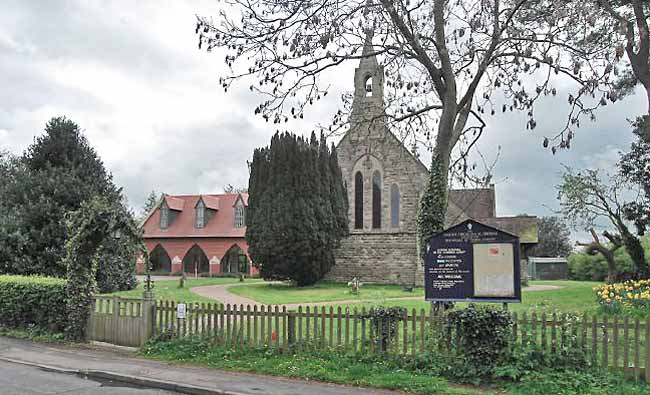
St. Thomas, Aslockton; the venue for the Spring Meeting and AGM, 2014 (Photo: David Hoskins).
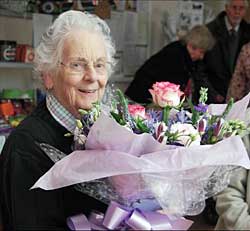
We were again blessed by a fine day, after a damp start, for our Spring Meeting at Aslockton. We were welcomed by Dr. Rosalys Coope who announced that this was to be her last AGM as President as she stepped down after eight years in this role. She entertained members with her memories of her early time on Council in the 50s as a young ‘whipper-snapper’, viewed with suspicion by the elderly male antiquarians then at the helm of the Society. She also remembered coming to this strange county on her marriage to Peter and viewing the house she still lives in - Mrs. Clifton, the then owner, formerly of Clifton Hall, on being asked why she wanted to leave such a pretty house answered, ‘Pretty yes, but on the wrong side of the Trent my dear!’. Rosalys said that she had been on the wrong side of the Trent ever since.
After this very special welcome by Rosalys, the AGM continued, chaired by Professor John Beckett.
Professor Beckett presented the annual report and following this John Wilson, Honorary Treasurer, talked through the accounts which showed that the Society was using its financial resources wisely and to good effect. He drew attention to the talk given by Michael Wood last year which had raised a substantial amount. Waiving a fee, Michael had asked that monies raised be used for a project in Laxton.
It was agreed that the subscriptions be raised by £1 from next year and John Wilson made a plea that members ensure their standing orders were changed accordingly and also that they check that their bank was paying the correct amount once only and not monthly as had happened to some members. The Chair thanked John Wilson and also Peter Bloomfeld who was our Independent Examiner.
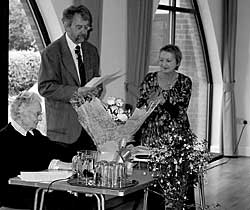
The presentation of flowers to the retiring President, Dr. Rosalys Coope
In his Chair’s remarks, Prof. Beckett noted that this year had seen the Society return to its roots with a talk after the lunch in November on W.P.W. Phillimore and it was now visiting Aslockton where the Revd. John Standish had been vicar. These two men had been the joint Honorary Secretaries appointed in 1897. However, John was of the view that it was probably the Revd. Standish who did most of the work!
Prof. Beckett paid tribute to Rosalys as she retired as our President, having been Chairman of Council for eight years and then a Vice-President. This was not, he said, the falling off the twig that Rosalys had been predicting for at least twenty years - she was still working, with Adrian Henstock and Pete Smith, on a composite volume of her work on Newstead Abbey and this work would be the subject of December’s lecture. Rosalys was presented with a standard fuschia and a bouquet of flowers.
On a sad note John informed members of the deaths of Bryan and Janet Churm this year. Bryan had very generously left his collection of local history books to the Society in order that the proceeds of their sale could benefit the Society. These books, amongst them some very choice titles, would be offered for sale to members in due course. The proceeds would be used to continue to update the Bibliography which Andy Nicholson had created and which was proving such a success.
Also a very well-used research resource was the Heritage Gateway which Denise Amos and Andy managed. Denise was at the meeting to show the Gateway to members and hopefully inspire more contributors. Another useful innovation was the e-bulletin which had been underway for just over a year, sending timely information to those signed up for it. It was proving a useful adjunct to the Newsletter, taking some of the copy pressure off this admirable magazine which Howard Fisher produced.
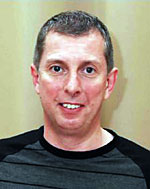
Mark Dorrington
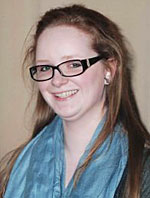
Hannah Nicholson
The Chair then turned to the membership of Council. He thanked Pauline Miller for her contribution to Council as she stepped down this year and he welcomed two new members, subject to the elections, Mark Dorrington, now Keeper of Manuscripts and Collections at the University of Nottingham, and Hannah Nicholson, who was particularly welcome in bringing a more youthful focus to Council.
He reminded those attending of the various events and initiatives relating to the commemoration of World War 1, especially the joint day school with the Nottinghamshire Local History Association on 25 October 2014.
Professor Beckett then urged the members to get more involved in the activities of the Society by such things as reviewing books, assisting at events or just informing Council of worrying developments.
He then commended the latest volume of the Transactions edited by Martyn Bennett and Keith Challis. Keith would be stepping down from the archaeology editorship during this year and a successor was being sought. John thanked his colleagues on the Society’s Council for their hard work over the past year. He noted that most of this goes unseen by the wider membership, but he assured the meeting that there is a great deal of effort put into making sure the Society runs efficiently and effectively.
Elections then took place and we were delighted that Adrian Henstock had agreed to become our President, following the illustrious line before him. Officers were all re-elected and Ken Brand, Richard Gaunt, David Knight, Penelope Messenger, Pete Smith and Margaret Trueman were re-elected and Mark Dorrington and Hannah Nicholson elected to serve on Council for the first time.
Adrian, on taking up the Presidency, gave an address which explained how he had been ‘encouraged’ to agree to his nomination by John Beckett with the words ‘You know you are it don’t you?’ Adrian noted that the first two Presidents had been dukes, the 6th Duke of Portland having been in that role for forty-five years without turning up to a meeting once! Adrian told members that he had become an officer forty years ago this year so he saw the Presidency as a kind of long-service award, feeling, as he did, rather humbled and honoured by the Society’s trust in him. Like Rosalys, Adrian said he wasn’t a Nottinghamshire native (although his mother and several of his ancestors were). He originated in Derbyshire and still had some loyalty, if only of a football nature, to that county.
He then spoke of his historical heroes who had inspired him in different ways. There were Dr. Robert Thoroton who, despite the problems of his time and a very busy professional life, had managed to produce the first history of the county in 1677 - it is, he said, very fitting that we continue to revere his name. The other heroes were Keith Train who appointed him a County Archivist and as Editor of the Transactions, and Neville Hoskins, his mentor, who gave him unassuming and kindly advice, especially on adult education matters. All doubts about whether he should take on the President’s mantle were overcome when Ann Hoskins told him that Neville would have approved. He then paid tribute to his predecessor, Rosalys, and expressed himself very pleased to be working with her on the Newstead Abbey volume. Finally he thanked John Beckett, having been Chair of Thoroton Council for twenty-two years and, in that time, gently guided the Society into the 21st century.
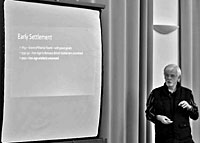
Gregg Redford talks about the history of Aslockton and Whatton
Following the business of the AGM, Gregg Redford, member of the Cranmer Local History Society, gave an interesting talk on Aslockton and Whatton.
We then had a super tea provided by members of the Cranmer Centre’s management team. It has to be acknowledged that the standard of Society teas continues to be of the highest quality!
After this, Valerie Henstock, aided by the new President, led members around Aslockton and Whatton, including visits to both churches. A very interesting and well-researched talk on Whatton Church was given by Janet Greasley.
It was another interesting and enjoyable Spring Meeting - we look forward to another next year.
Recent Lectures
The Maurice Barley Lecture; 8 February 2014
Darren Turner: Port Wine, Patronage and a Provincial Architect: The Early Work of Watson Fothergill.
Darren started by reminding members of the familiar Fothergill buildings in central Nottingham, all from his later ‘brickwork’ period. These included Queen’s Chambers (1897) on the corner of Long Row and King Street, the former store for Jessop & Son on King Street (1896), and his own office 15-17 George Street (1895). All were inscribed with the date and proud pronouncement Watson Fothergill Architect.
Then Darren turned to his main theme reminding us that the architect was born in Mansfield in 1841 as Fothergill Watson, the second son of Robert Watson’s second marriage. Robert died in 1852 and not long after the family moved to the Sandfield area of Nottingham.
Fothergill left school at the age of 15 in 1856 and was articled to the architect surveyor Frederick Jackson. In 1860, on completing his four years of pupillage with Jackson, he went to work for Isaac Charles Gilbert on Clinton Street, Nottingham. After 18 months he moved to London and spent two yeras in the office of (Sir) Arthur Blomfield.
This was followed by another short stay with John Middleton in Cheltenham before returning to Nottingham in the summer of 1864 to commence practice as an architect sharing premises with Gilbert at 6, Clinton Street, where he was to remain for the next 30 years. For the next few years he worked on projects with or for Gilbert. Gilbert was architect to the Brunt’s Charity of Mansfield, an appointment taken over by Fothergill as preferred architect in December 1872. His half-brother, Robert Mackie Watson, was chairman of the charity.
Fothergill’s work for Brunt’s was extensive. He was surveyor for all their land and property in Nottingham and some of his impressive buildings were erected on Brunt’s land, notably the rebuilt Black Boy Hotel and the Express newspaper offices on Parliament Street.
On 10 September 1867 Fothergill had married Anne Hage, the daughter of Samuel Hage, one of the founding partners of Mansfield Brewery. When Samuel died in 1877 he left most of his estate to his daughter. The value of the brewery’s shares was considerable and certainly from this time the Fothergill family’s lifestyle changed - upwards. The port wine of the lecturer’s title ties in to this estate!
In the 1870s, as Fothergill was establishing himself in Nottingham, following his award winning entry for the new Temperance Hall (later Albert Hall) in 1874, he was also acting as the Consulting Architect to the Improvement Commission in Mansfield. Other early work in that town he had obtained through his father-in-law, his sister and his half-brother Robert. By the end of the decade he was disillusioned with his links with the Improvement Commission and confined himself mainly to Nottingham where his High Victorian Gothic edifices; the Nottingham & Notts. Bank on Thurland Street, the Albert Hall and the Express building were now features of the town.
Darren emphasised the point that three men influenced Fothergill’s early professional years: I. C. Gilbert, his father-in-law Samuel Hage, and his half-brother Robert Watson. In 1892, his 52nd year, he transposed his forename and family name thus becoming Watson Fothergill.
Ken Brand
The Myles Thoroton Hildyard Lecture; 8 March 2014
Derek Wileman: The Southwell Workhouse
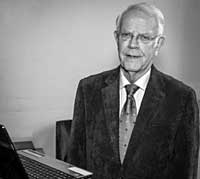
Rightly assuming that most Thoroton members will have visited the iconic Southwell Workhouse and will be familiar with details of the building, our speaker expanded on its role and the people in charge of it. Derek Wileman is one of the team of National Trust volunteers who help to promote the Workhouse. He has been involved from its opening, some sixteen years ago, and has become its lead speaker giving talks to a wide variety of audiences. He completed an MA in English Local History at Leicester University with a dissertation based on the Poor Laws and how they were used in Nottinghamshire parishes between 1820 and 1850.
For our talk he concentrated on the role of the Guardians and the personalities of the Master and Matron, together with a picture of the local suppliers who served the Workhouse. As responsibility for social welfare moved from individual parishes to a more centralised structure in Union Workhouses they also took on administration of registration of births and marriages, censuses, planned water supplies and drains. A Board of Guardians had to be elected with representatives of each of the parishes involved and they had the job of appointing full and part-time staff to administer these functions. Members of the Board were often JPs who could be expected to have some experience of social problems, although examination of the attendance records shows that they were not particularly conscientious in their involvement.
As the Master and Matron were in control of day to day running of the Workhouse our speaker gave more details of the personalities involved and their salary and perquisites. To provide a closer picture of who might have become an inmate he also gave more detail of the case of one individual and how she had become admitted. This kind of background information would not appear in the guidebook or as part of the audio guide used for visitors at Southwell so we had a particularly interesting afternoon. By comparison with today’s problems in the NHS it does seem that history is often repeated - creation of Union Workhouses is comparable with the closure of cottage hospitals and the rise of super hospitals such as Kingsmill!
David Bagley
The Social World of Nottingham’s Green Spaces: conference reports
By Judith Mills
Twice during 2013, I reported on the Nottingham Green Spaces project led by John Beckett. It investigated the diverse uses of the green spaces created by Nottingham’s 1845 Enclosure Act: the Forest, the Arboretum, the Cemeteries, and the Walks (Corporation Oaks, Elm Avenue, Robin Hood Chase, Waterloo Promenade and Queen’s Walk). We worked in collaboration with the Friends of The Forest, Friends of Nottingham Arboretum, the Very Local History Group, the Civic Society and the City Council. The project ended in January 2014 and to celebrate the work we held two public conferences, both of which were attended by members of the Thoroton Society, amongst many others.
The theme of the first conference, held in Highfield House, University of Nottingham on 10 January 2014, was the development and use of public urban spaces across the country. Desmond O’Grady, Head Groundsman at the University, opened the conference with an introduction to the campus gardens and grounds; and the weather, though cold, was dry enough to allow the Walled Garden to be explored over lunch. Dr Katy Layton-Jones then discussed children’s pageants, fairy gardens, pirate ships and other idealised notions of childhood in Liverpool’s parks at the beginning of the twentieth century. Whilst intended for children’s enjoyment, these entertainments were planned and appreciated by adults whose perhaps romantic idea of childhood may not have matched the reality. Katy’s talk was followed by two presentations, one by Professor Robert Lee and one by Dr Carole Reilly, which addressed the anti-social, illicit and immoral uses of parks, from the end of the nineteenth through the twentieth centuries. Dr Mark Johnson then changed the focus by explaining the evolution, advantages and problems associated with the planting of trees in urban streets. Finally, Dr Jan Woustra gave a critical appraisal of the recent HLF-funded restoration of Weston Park, Sheffield, emphasising the importance of using historical sources to inform such work. The Nottingham project team – John Beckett, Paul Elliott, Judith Mills and Jonathan Coope – also gave presentations on the Green Spaces project.
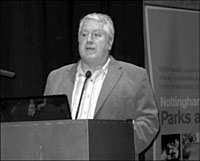
Councillor Dave Trimble speaking on 18 January (photo Judith Mills).
In contrast, the second conference, held at Nottingham Contemporary on 18 January, focused specifically on Nottingham’s green spaces, in particular those studied by the project. Councillor Dave Trimble opened the conference by outlining the Council’s commitment to preserving green space in the City and the efforts made to fund this work. John Beckett then explained the background to the Enclosure Act and the part played by some of Nottingham’s leading citizens in raising awareness of the need for open space to provide ‘green lungs’ in heavily polluted, industrial cities. The passing of the 1845 Enclosure Act led to the development of the ‘common’ fields for housing, yet at the same time by creating open spaces ensured the preservation of significant parks and recreation grounds across the city. This theme was picked up by June Perry (Friends of The Forest) who argued for the importance of historical research in safeguarding open spaces against over-development and ensuring that they are still used for their original purposes. June’s presentation was complemented by a talk from Val Wood and Margaret Knowles (Friends of Nottingham Arboretum) on the early twentieth-century ‘open air movement’ which infuenced the building of open-air schools, lidos and a renewed emphasis on fitness and fresh air. Margaret also described the – perhaps surprising – story behind the Aviaries and their occupants. Kevin Powell, who conducts excellent guided tours of the General and Church (Rock) Cemeteries on behalf of the Civic Society, then talked about the foundation of these ‘out of town’ landmarks, some of their ‘residents’ and why these cemeteries were eventually closed. Over the years, Nottingham’s green spaces have featured in magazines and newspapers, and on postcards: Paul Elliott showed some of these images, explaining how they can be used as research sources not only for examining changing trends and fashions in the past but also how the spaces were promoted as appropriate places for use by women and families.
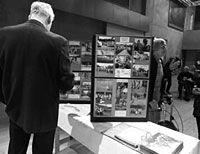
Viewing the Friends of the Forest exhibition (photo: Judith Mills).
An important element of the conference were the displays by not just those groups involved in the project but other organisations involved with aspects of green spaces and the history of Nottingham. These included the Local Studies Library, a project of the development of East Croft (currently waste ground), photographs of some of the Goose Fair showmen and the recent restoration of St Ann’s Allotments. After lunch, Mo Cooper, Heritage Officer at St Ann’s Allotments, gave a fascinating account of the history of the Allotment Gardens, the restoration project and future plans for further research and community engagement. There was then a change of pace as James Dymond, City Council, led a short quiz about the City’s parks which was followed by small-group discussions about potential topics for future research.
Although the project has ended, over the next few months the work will be written up into articles for journals and the project website will be maintained and regularly updated for the foreseeable future. For more information on the project, please visit www.ng-spaces.org.uk